Answered step by step
Verified Expert Solution
Question
1 Approved Answer
Note: Except for the option E written in the table, all other options are correct. I would appreciate if you could help me with option
Note: Except for the option E written in the table, all other options are correct. I would appreciate if you could help me with option E. But we know that the answer 8,968.88 for option E is wrong. 


Step by Step Solution
There are 3 Steps involved in it
Step: 1

Get Instant Access to Expert-Tailored Solutions
See step-by-step solutions with expert insights and AI powered tools for academic success
Step: 2

Step: 3

Ace Your Homework with AI
Get the answers you need in no time with our AI-driven, step-by-step assistance
Get Started


